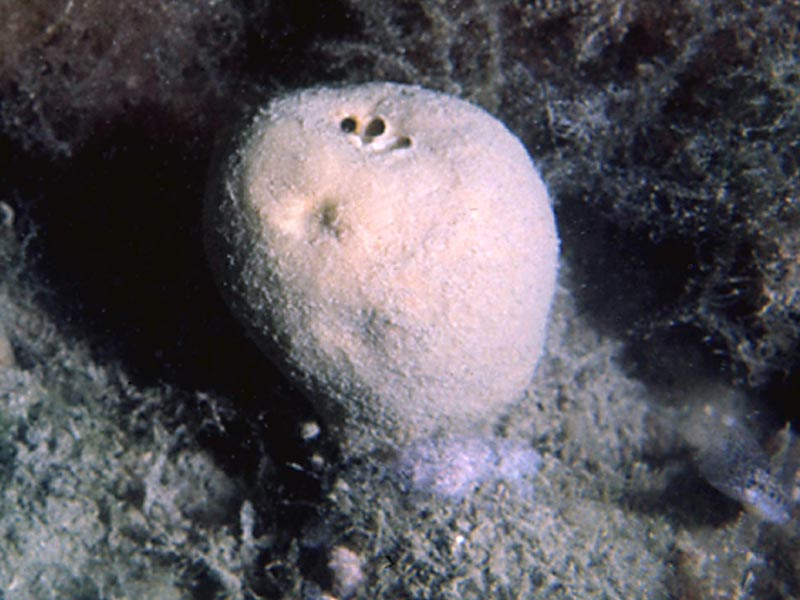A sponge (Suberites carnosus)
Distribution data supplied by the Ocean Biodiversity Information System (OBIS). To interrogate UK data visit the NBN Atlas.Map Help
| Researched by | Georgina Budd | Refereed by | Admin |
| Authority | (Johnston, 1842) | ||
| Other common names | - | Synonyms | Hymeniacidon carnosa (Johnston, 1842) |
Summary
Description
Recorded distribution in Britain and Ireland
Widespread along Atlantic facing coasts of Britain and Ireland.Global distribution
Common in the NE Atlantic and Arctic. Distribution extends south to the Mediterranean.Habitat
Usually in clean water where currents are not strong on circalittoral rock (often vertical surfaces).Depth range
-Identifying features
- Growth form cushion, massive-lobed or massive fig-shaped and stalked, up to 15 cm in height.
- Yellow, buff or orange in colour.
- Single apical surface osculum, or several in massive-lobed form
- Surface even and smooth to touch.
- Smells faintly of freshly cut Laminaria stipe.
- Dramatic contraction to about ¼ of its fully expanded size when disturbed.
- Skeleton consists of siliceous spicules, megascleres (325-500 µm) requiring microscopic examination for identification. Microscleres are absent.
- The spicules of Suberites carnosus are classified as tylostyles (pin-like with a pinched bulbous end).
Additional information
SkeletonFor examination, magnifications of x 100 to x 1000 are required. The skeleton consists of spicules, tylostyles, of two distinct sizes. The largest constitute the main structural megascleres, whereas the smaller are perpendicularly arranged plumose brushes at the surface. The structure is subradiate, the radial arrangement of the spicules being most apparent near the surface. Internally the skeleton is confused and almost 'halichondriod' (like that of the Family Halichondrida, where the spicules of the endosomal skeleton are in disarray). In the stalk region the spicules are condensed to form an axial skeleton (Moss & Ackers, 1982).
Other species
Suberites ficus is another common sponge. It is usually found on hard substrata where there are tidal currents and also on wreckage where it hangs down into the current. It has a similar growths form to Suberites carnosus but may also be cylindrical. Colours include white, grey marbled and green in addition to orange. Surface and endosomal skeleton differ. Differences between Suberites carnosus and Suberites ficus (as S. domuncula) are based on criteria communicated by S.M. Stone in Moss & Ackers (1982).
Listed by
- none -
Bibliography
Hayward, P.J. & Ryland, J.S. (ed.) 1995b. Handbook of the marine fauna of North-West Europe. Oxford: Oxford University Press.
Howson, C.M. & Picton, B.E., 1997. The species directory of the marine fauna and flora of the British Isles and surrounding seas. Belfast: Ulster Museum. [Ulster Museum publication, no. 276.]
Moss, D., & Ackers, G. (eds.), 1982. The UCS Sponge Guide. Produced by R. Earll. Ross-on-Wye: The Underwater Conservation Society.
Van Soest, R.W.M., Picton, B. & Morrow, C., 2000. Sponges of the North East Atlantic. [CD-ROM] Windows version 1.0. Amsterdam: Biodiversity Center of ETI, Multimedia Interactive Software. [World Biodiversity Database CD-ROM Series.]
Datasets
Centre for Environmental Data and Recording, 2018. Ulster Museum Marine Surveys of Northern Ireland Coastal Waters. Occurrence dataset https://www.nmni.com/CEDaR/CEDaR-Centre-for-Environmental-Data-and-Recording.aspx accessed via NBNAtlas.org on 2018-09-25.
Fenwick, 2018. Aphotomarine. Occurrence dataset http://www.aphotomarine.com/index.html Accessed via NBNAtlas.org on 2018-10-01
Manx Biological Recording Partnership, 2022. Isle of Man historical wildlife records 1990 to 1994. Occurrence dataset:https://doi.org/10.15468/aru16v accessed via GBIF.org on 2024-09-27.
National Trust, 2017. National Trust Species Records. Occurrence dataset: https://doi.org/10.15468/opc6g1 accessed via GBIF.org on 2018-10-01.
NBN (National Biodiversity Network) Atlas. Available from: https://www.nbnatlas.org.
OBIS (Ocean Biodiversity Information System), 2025. Global map of species distribution using gridded data. Available from: Ocean Biogeographic Information System. www.iobis.org. Accessed: 2025-08-14
Citation
This review can be cited as:
Last Updated: 12/07/2002



